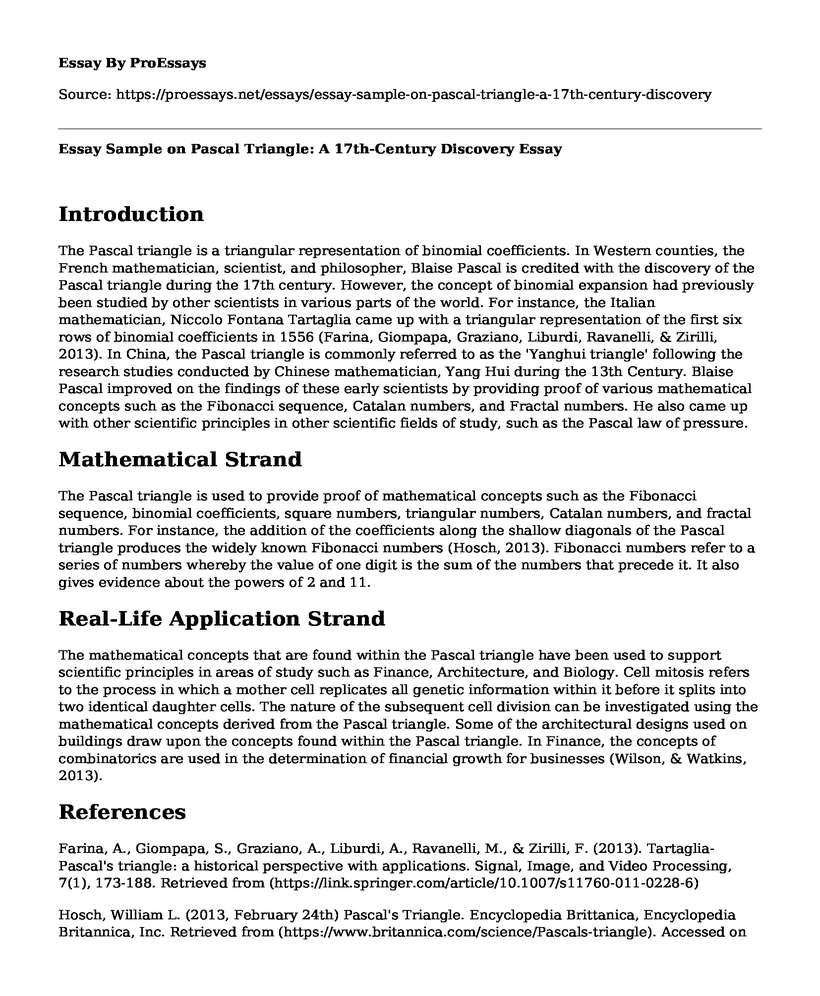Introduction
The Pascal triangle is a triangular representation of binomial coefficients. In Western counties, the French mathematician, scientist, and philosopher, Blaise Pascal is credited with the discovery of the Pascal triangle during the 17th century. However, the concept of binomial expansion had previously been studied by other scientists in various parts of the world. For instance, the Italian mathematician, Niccolo Fontana Tartaglia came up with a triangular representation of the first six rows of binomial coefficients in 1556 (Farina, Giompapa, Graziano, Liburdi, Ravanelli, & Zirilli, 2013). In China, the Pascal triangle is commonly referred to as the 'Yanghui triangle' following the research studies conducted by Chinese mathematician, Yang Hui during the 13th Century. Blaise Pascal improved on the findings of these early scientists by providing proof of various mathematical concepts such as the Fibonacci sequence, Catalan numbers, and Fractal numbers. He also came up with other scientific principles in other scientific fields of study, such as the Pascal law of pressure.
Mathematical Strand
The Pascal triangle is used to provide proof of mathematical concepts such as the Fibonacci sequence, binomial coefficients, square numbers, triangular numbers, Catalan numbers, and fractal numbers. For instance, the addition of the coefficients along the shallow diagonals of the Pascal triangle produces the widely known Fibonacci numbers (Hosch, 2013). Fibonacci numbers refer to a series of numbers whereby the value of one digit is the sum of the numbers that precede it. It also gives evidence about the powers of 2 and 11.
Real-Life Application Strand
The mathematical concepts that are found within the Pascal triangle have been used to support scientific principles in areas of study such as Finance, Architecture, and Biology. Cell mitosis refers to the process in which a mother cell replicates all genetic information within it before it splits into two identical daughter cells. The nature of the subsequent cell division can be investigated using the mathematical concepts derived from the Pascal triangle. Some of the architectural designs used on buildings draw upon the concepts found within the Pascal triangle. In Finance, the concepts of combinatorics are used in the determination of financial growth for businesses (Wilson, & Watkins, 2013).
References
Farina, A., Giompapa, S., Graziano, A., Liburdi, A., Ravanelli, M., & Zirilli, F. (2013). Tartaglia-Pascal's triangle: a historical perspective with applications. Signal, Image, and Video Processing, 7(1), 173-188. Retrieved from (https://link.springer.com/article/10.1007/s11760-011-0228-6)
Hosch, William L. (2013, February 24th) Pascal's Triangle. Encyclopedia Brittanica, Encyclopedia Britannica, Inc. Retrieved from (https://www.britannica.com/science/Pascals-triangle). Accessed on 19th May 2019.
Wilson, R., & Watkins, J. J. (Eds.). (2013). Combinatorics: ancient & modern. OUP Oxford. Retrieved from (https://books.google.co.ke/books?hl=en&lr=&id=hRmMp4D12PIC&oi=fnd&pg=PP1&ots=nnwb3FEvuX&sig=qtmH1mp8kwMe7p3n2YKyrpsOZWo&redir_esc=y#v=onepage&q&f=false)
Cite this page
Essay Sample on Pascal Triangle: A 17th-Century Discovery. (2023, Jan 12). Retrieved from https://proessays.net/essays/essay-sample-on-pascal-triangle-a-17th-century-discovery
If you are the original author of this essay and no longer wish to have it published on the ProEssays website, please click below to request its removal:
- The Human Prospect Essay
- Autonomy, Liberty Rights, and the Principle of Noninterference in Drugs and Alcohol
- Reflection Paper on MENO in the Book "Plato's Five Dialogues"
- Paper Example on Theories of Kant and Spinoza
- Man's Nature Is Good: Annotated Bibliography
- Essay Example on Ethical & Legal Implications in Nursing Practice
- Why People Volunteer - Free Essay Sample







